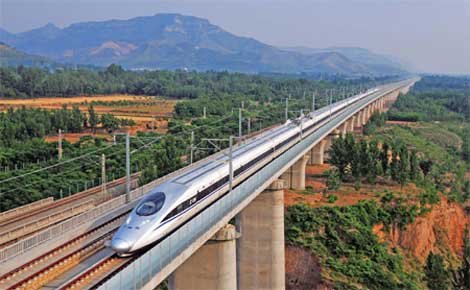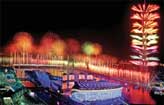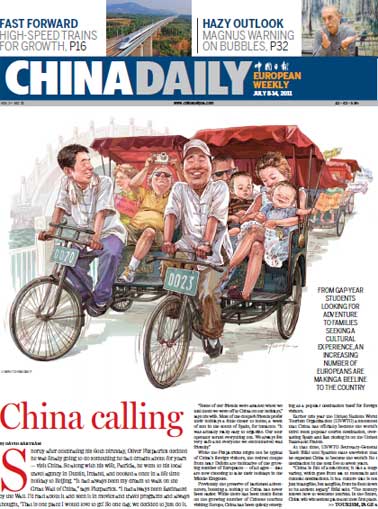Safeguarding train technologies
Updated: 2011-07-08 11:09
By Xin dingding (China Daily European Weekly)
 |
|
A CRH380A train, developed by CSR Corporation, runs on the Beijing-Shanghai high-speed railway. Provided to China Daily |
In a written reply to China Daily recently, Li Jun, director of the general affairs office of the transport bureau under the Ministry of Railways, says that China has filed 21 patent applications under the PCT system. The subjects of the applications include the high-speed trains' assembly, hull and bogies, and the patents are filed in regions including the United States, Brazil, Europe, Russia and Japan.
 |
Li says that so far, eight of the 21 applications have passed a preliminary examination in the international procedure, and entered the national procedure. At home, 1,902 applications concerning high-speed railways have been filed, for which 1,421 patents have been issued.
The patent applications under the PCT system were mainly filed by China CNR Corporation Ltd and China Academy of Railway Sciences since 2009, Wang Yongping, the ministry spokesman said on July 7. China CNR Corporation is one of China's two manufacturers of high-speed trains that developed the CRH380B train.
The efforts are expected to pave the way for China's railway enterprises to explore overseas high-speed rail markets.
CSR Corporation Ltd, the other major manufacturer, is also considering applying patents for its CRH380A train in the United States.
CSR and General Electric (GE) signed a joint venture agreement last December to make high-speed trains in the United States.
According to Liu Gang, deputy director of the equipment department of the transport bureau under the ministry, CSR and GE are in discussions about transferring CSR's high-speed train technologies to GE. Earlier media reports said that GE was interested in the CRH380A, a model that CSR developed for the Beijing-Shanghai high-speed railway with a top design speed of 380 km/h.
Zhou Li, an official with the transport bureau, said in mid-June that to make sure the cooperation does not infringe on other parties' intellectual property rights, CSR and GE have carried out research concerning the intellectual property rights of CSR's high-speed trains. "Property rights experts from home and abroad and GE's legal consultants studied some 200 patents and concluded that none will generate disputes," he said.
Ma Yunshuang, deputy president and technology director of CSR Qingdao Sifang Co Ltd which developed the CRH380A train, explains the train's technologies, although based on Japanese technologies, are innovations.
Japan's Kawasaki Heavy Industries transferred to China the technologies of a 200-kilometer per hour train in 2004. In the same year, China also bought the technologies for 200-250-km/h trains from Bombardier and France's Alstom. In the following year, China inked a deal with Siemens from Germany, which agreed to transfer the technologies of a 300-km/h train and formed a partnership with Tangshan Railway Vehicle Co Ltd under China CNR Corporation Ltd, the other major manufacturer.
CSR Qingdao Sifang Co Ltd partnered with Kawasaki Heavy Industries and produced the 200 km/h trains called CRH2 in China. The CRH2 trains were operated on upgraded old lines in the country's sixth railway speed-up in 2007.
Then the company did what the Ministry of Railways called "the introduction-assimilation-secondary innovation strategy".
Ma explains that the CRH380A train is the result of secondary innovation.
After the technology transfer was made, the company's research and development team did a lot of reverse engineering to absorb the technologies and prepare for its own innovations.
"We did analysis and experiments on every part, trying to understand the design concept and the form of the technology used and to figure out what we should do to make it work as we wanted," he says.
With the knowledge gained from this reverse engineering, the R&D team made changes to the train's key parts including the bogie and the head, in order to develop new train models that better suit China's railway conditions, which are different in many ways from Japan's, he says.
For example, China's trains run on ballastless tracks, but in Japan, trains run on ballast tracks. Also, China's railway tunnels have a cross section of 100 square meters, but in Japan the railway tunnels have a cross section of 64 sq m. These differences have a big impact on the operation of trains.
To evaluate the results of the changes they made, the team built a prototype and put it through exhaustive tests on existing high-speed railways, recording all the data and analyzing it, and then making further adjustments.
According to Ma's estimation, more than 100 million yuan (10.8 million euros) was spent on developing the CRH380A, 10 times the amount the company spent on the development of trains in the past.
"Some experiments we did were exclusive, because they were carried out on high-speed railways, such as the Wuhan-Guangzhou and Zhengzhou-Xi'an lines, for months, which others are not able to do," he says.
Ma and his colleagues spent months on the high-speed railways conducting tests. Sometimes, the tests started at 3 am and lasted until the following afternoon.
Ma refutes suggestions that their innovations were all peripheral, such as installing a boiler or changing the inner decoration, and says their efforts have led to innovations on many parts of the high-speed trains, including three key parts: the bogie, train head and train hull.
The bogie, similar to an automotive chassis, is a key part of high-speed trains. Every bullet train carriage has two bogies able to carry a certain load smoothly.
Changes to the bogie prototype were necessary, because China's track is different from Japan's. Also, CSR was later given the tasks to develop 300 km/h trains and 380 km/h trains, and the bogie is a part that must be changed to sustain the higher speeds. The bogie prototype Japan transferred to China in 2004 was unsuitable as it was designed for 200-250 km/h trains.
Based on copious data gained from months of experiments on the Wuhan-Guangzhou and Zhengzhou-Xi'an high-speed railways, Ma's team successfully made adjustments to the bogie prototype permitting trains to run smoothly at 380 km/h.
"If you compare the bogie prototype imported from Japan with the current bogie used on the CRH380A, you will find they are different," he says.
In addition to the bogie, the company redesigned the train head, reducing the air friction by 5 percent compared to that of the CRH2.
Also, after more than a year's work, the company mastered the technology of manufacturing large-section materials for building a light but sturdy train hull, which Japan wanted to sell rather than transfer. Based on the new materials, the company redesigned the train car body to guarantee the train's strength and provide comfort to passengers with less noise.
"Our technologies may originate from foreign countries, but that does not mean what we have now belongs to them. We have added the knowledge we gained from experiments and made designs to satisfy our needs, so the new train is not theirs any more," he says.
In CSR's development of 300-350 km/h trains and later 380 km/h trains, foreign companies have supplied some of the parts. "But all the parts bought from foreign companies are tailor-made according to CSR's technical requirements," he says.
Li Jun explains that China's high-speed train manufacturers use foreign companies to supply some parts and materials including bearings, weather resisting steel plates, wagon axles and high-tension cables, because the country's industrial capability cannot supply durable parts for high-speed trains.
The world's high-speed railway technologies evolved through learning, and most of the world's leaders in this field have also imported technologies from abroad when they first set about, railway experts say.
Li says that in the next stage, the ministry is organizing engineers to develop a 400 km/h rail inspection train, a 500 km/h super-fast experimental train and a new generation of high-speed trains.
Zhou Wenting contributed to this story.
E-paper

Burning desire
Tradition overrides public safety as fireworks make an explosive comeback
China calling
School of hard knocks
Pen mightier than the sword
Specials

90th anniversary of the CPC
The Party has been leading the country and people to prosperity.

My China story
Foreign readers are invited to share your China stories.

Green makeover
Cleanup of Xi'an wasteland pays off for ancient city
